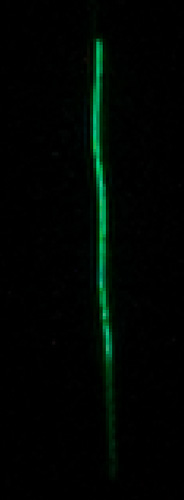In the preceding post, I tested the Zeiss 100mm f/2 Makro Planar ZF mounted on a Sony a7R with the Novoflex Nikon-lens-to-E-mount adapter with the Novoflex rotating tripod collar attaching both to an Arca-Swiss Monoball head and Gitzo GT3541XLS legs, with the first set extended all the way and the next one half way. I used this setup because the Novoflex rotating tripod collar is incompatible with the RRS quick-release clamp that I use on the Arca-Swiss C1 cube; when the clamp is closed the foot can still slide back and forth. Not having the Cube makes it hard to square up the target in the frame, and further images will be made by bolting a RRS plate on the Novoflex foot with a 3/8 inch screw, and mounting that to the Cube.
In the preceding post, it looks like we were seeing vibrations in excess of one camera pixel peak-to-peak, so I wanted to make some oscilloscope photographs to see if I could pin down the nature of the vibrations. I didn’t change the tripod or head for this series, because I wanted the setup to be directly comparable to the ISO 12233 images in yesterday’s post.
Knowing that we’re looking at high-frequency vibrations, I set the scope time base to 5 msec/division, and the shutter speed to 1/40 second. That will give a trace that’s 8 divisions wide.
Here’s what I saw with the camera in the portrait position, and the scope time base moving horizontally. The image is enlarged 4x using nearest neighbor:
We can see a vibration of about 3 pixels peak to peak, but we can’t tell too much about its nature. Enlarging the original image in Photoshop by 12x vertically and 2x horizontally using Preserve Details gives us this:
You can see an underdamped vibration of about 70 Hertz with an amplitude of about two pixels peak-to-peak, with underdamped higher frequency components of roughly the same amplitude that die away faster. One of the high frequency components appears to be at about 200 Hz.
Using a function generator with the output set to sawtooth on the vertical axis of the scope and roughly the same frequency, and turning off the internal sweep generator that drove the horizontal axis in the above photographs, we can look at the horizontal motion of the camera. Here it is at 4x with nearest neighbor:
And here’s what it looks like at 18x horizontal and 3x vertical using Preserve Details:
The high-frequency components are less evident, but the 70 Hz component is even bigger. This squares with the results of the ISO 12233 tests in the preceding post. The trace rises from the bottom to the top, and is not perfectly vertical.
Based on these images, it’s pretty clear why the Zeiss 100mm lens and the Novoflex collar is a difficult setup to use for the sharpest possible images on the a7R unless the shutter speed is 1/500 second or higher or ¼ second or lower. I may repeat the tests with the RRS tripod and the Cube, but I expect similar results.




Leave a Reply